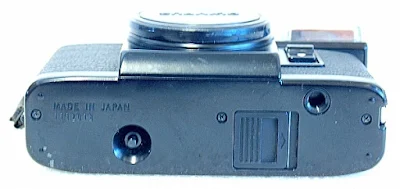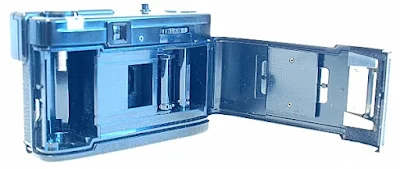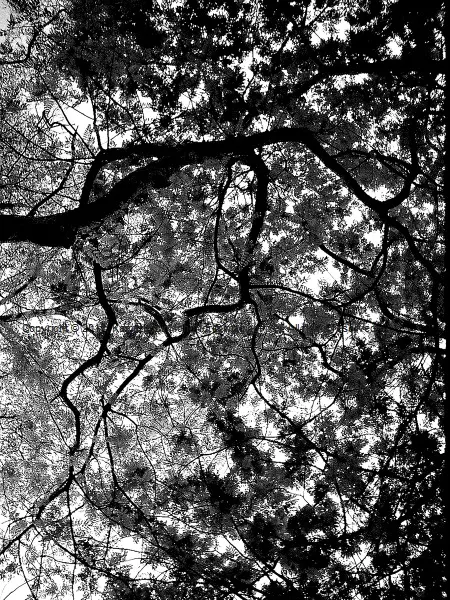Rather than having the same all-metal construction as the Pen EE models, the EF has a very attractive all-black hard-wearing plastic body with white lettering and a built-in flash.
Just like the earlier EE model cameras, the EF is still a true point-and-shoot camera, complete with its selenium-powered light-averaging automatic exposure system, a fixed focus wide-angle 4-elements in 3-groups G Zuiko 28mm F3.5 lens with a focal range from 1.4 meters to infinity. The EF has a programmed shutter speed with a range from 1/35 second at F3.5 to 1/250 second at F22 and accepts film ISO speeds ranging from 25 to 400.
The EF is also fitted with the red pop-up flag system for underexposure, as seen on other Pen EE models. The red flag will lock the shutter when activated and be released when the flash is set to on. The automatic electronic flash, powered by a single AA battery cell, can go for up to 150 flashes with a single alkaline battery, with a recycling time of about 7 seconds.
Oly35mm Review - Pen EF
In 1981 we saw the last of the Olympus half frame cameras, the Pen EF. It was hardly a grand farewell, but was a nice little simple snapper that harked back ...
As noted, while the camera's programmed EE (Electronic Exposure) meter is powered by the silicon cell, the flash is still a battery to run. You can still use the camera without the battery (for the flash) installed, and if you are up to it, do the shutter lock trick with this setting, i.e., pop up the flash to disengage the red pop-up underexposure flag, and shoot at the slower shutter speed and widest aperture.
Basic Camera Features
A handsome lass, no less. On a 35mm full-frame camera, the wide-angle 28mm lens will be the equivalent of a 40mm focal length lens, just like images captured with an Olympus Trip 35. Image size in the half-frame format, however, is 18x24mm, oriented vertically (3:4 portrait orientation). The lens will take later 43.5mm screw-in filter sizes, not the earlier 22.5mm sizes.
A simple front, not exactly regular, with the slide-out flash unit bulging out of the top right corner of the brickbat. Next to the flash unit is the viewfinder window with the lens mount housing centered on the lower front. The etched numerals for the film ISO speed setting are on the concentric ring at the base of the lens mount housing, and the red aligning mark to set the reading is etched on the outer rim of the filter ring, which can be rotated freely between the ISO speed settings.
On the top plate, to the left, just aft of the flash/viewfinder raised ridge, is the film rewind crank. Right on the edge, back from the film rewind crank, is the flash-ready pilot light. To the right of the top plate are the shutter button and the frame counter window.
A simple back, with the flash-ready pilot light, the viewfinder eyepiece, and the film forward thumb crank on the upper part of the film back, and the non-interchangeable hinged film back, with a release latch system for opening and locking it in place, fitted with a flash distance calculator panel sticker, across the whole film box. The pull-down release latch for the film back is located on the front lower edge of the camera's left shoulder.
On the bottom plate, the battery chamber access, film rewind release button, and tripod socket.
`The film box is a standard quick-load system with the normal configuration of the film canister chamber, shutter frame window, sprocket gear, and multi-slot take-up spool.
Film Loading and Rewinding
Film loading is standard as done with most 35mm film cameras, with the film canister loaded in the chamber on the left of the film box, the film end pulled across the film back, tensioned, the perforations aligned with the sprocket gear, and the tab end inserted into one of the slots on the inner side of the take-up spool. The film is wound emulsion side up.
Film rewind is done by first pressing the rewind release button located on the bottom plane of the camera, and using the rewind lever to rewind (clockwise) the film roll back into the film canister.
Exposure Readout
The Olympus Pen EF is fitted with a bright frame finder with etched frame lines, with only the red pop-up underexposure flag showing when activated.
Exposure Lock Trick
The true exposure lock trick is done by first pointing the camera to a much brighter light source, one which will not trigger the red-flag lockout, half-pressing the shutter release to lock in the exposure reading, before reframing the image and releasing the shutter button fully.
Compared to the flash-on method mentioned earlier, where the shot will be taken at the slower shutter speed and widest aperture, this light source method will be shot at the shutter speed and aperture opening locked by the exposure meter.
Battery
The Pen EF requires the use of a single AA battery cell to power the flash unit.
Camera Body Weight
The camera weighs 280 grams without batteries.
Portrait Orientation
One interesting aspect of the vertical film framing of the Olympus Pen EF is the ease of using the camera for portrait-framed shots. This is simply done with the camera held normally in its horizontal position.
Portrait framed images are not only commonly used for portraits (but of course), but are equally adept with architecture themes, especially of tall buildings, and surprisingly, of nature and landscapes as well.
Using the Camera
For a casual photographer, using the point-and-shoot Olympus Pen EF is about as handy as you can get for images that are surprisingly well-delineated. No hidden tricks here, just hold the camera to your eye, frame the scene, and press the shutter. Images will always be clear and sharp with enough ambient light to get the programmed shutter going.
For the more creative, try adding on to your shooting style, shoot from the hip, with the camera held at arm's length or above your head, learn to frame the image with mind and hand, or go Which Way? When to Photograph in Portrait or Landscape Orientation. You might be in for a surprise at your own creativity.
Images posted were originally shot in color (Fujifilm Superia 200), scanned, and post-processed on Olympus Viewer 3 (OV3) for image edits and black-and-white conversion.






















BTW, the meter is powered by a selenium cell, not a silicon diode.
ReplyDeleteThanks for the heads-up, regards.
Delete